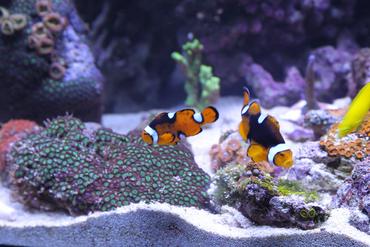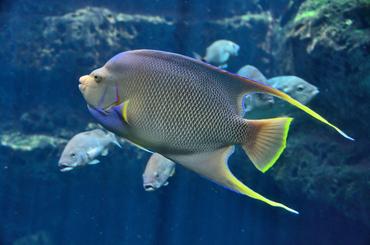HOW TO MODIFY PH IN A SALTWATER TANK

Updated
Learn how to modify the pH in your saltwater tank so you can correct pH problems if they occur.
The pH level in your saltwater tank is incredibly important for the health and vitality of your tank. If the pH falls too low or spikes too high, your fish could become stressed and fall ill -- they may even die as a result.
Regardless whether you are a novice or experienced aquarium hobbyist, you have probably heard about the importance of pH in a saltwater aquarium. Maintaining a stable pH level is essential for keeping your fish healthy and it is something you should keep an eye on through routine water tests. In the event that the pH in your tank does change, you should have a basic understanding of how to modify saltwater aquarium pH so you can remedy the situation before you fish can be negatively affected by the change.
What is PH?
Aquarium pH is simply a measure of how acidic or alkaline the water in your tank is. PH is typically measured on a scale from 0 to 14, with 7.0 being a neutral pH. All pH levels below neutral are described as acidic while levels above 7.0 are alkaline. A saltwater aquarium should generally be kept at a pH between 7.6 and 8.4, but the specific pH recommended for your tank may depend on the species you have in the tank. If you are keeping a reef tank, the recommended pH level may actually be higher – between 8.0 and 8.4. The ideal pH range for your tank will depend on the species of fish, corals and invertebrates you have in the tank so you should perform some basic research on your tank inhabitants in order to determine the best pH for your particular tank.


Causes for Changes in PH
Over time, your saltwater tank will trend toward a lower pH as acids are added to the aquarium. These acids may result from excess carbon dioxide production resulting from respiration or it could be due to a lack of sufficient gas exchange within the tank. Other causes for low pH may include nitric acid build-up from biological filtration and the production of organic acids from metabolic waste products. Natural sea water contains a variety of chemicals such as bicarbonate, calcium, borate and hydroxide which act as “buffers” to protect against changes in pH. In the saltwater aquarium, these chemicals must be maintained in order for the tank to have a stable pH. Over time, these buffers may wear out which could contribute to changes in aquarium pH.
Modifying Aquarium PH
The best method to ensure pH stability is to perform routine water changes – these water changes will refresh the natural buffers in your aquarium water and they will also help restore the trace mineral content. Removing accumulated waste and uneaten fish food will also help to keep the pH in your tank stable. In the event that your aquarium pH drops suddenly, there are several ways you can remedy the situation. Adding bicarbonate of soda (baking soda) to the tank at a rate of one teaspoon per twenty gallons is a simple way to increase aquarium pH but it is best done slowly so the buffers in your tank have time to adjust to the new pH.
If the pH in your tank becomes too high, you can try adding vinegar or carbon dioxide to the tank. Adding one mL of distilled white vinegar per gallon of tank water will help to reduce the pH in your tank by about 0.3 units. Another option is to add carbon dioxide directly to the tank by using bottled soda water. Adding six mL of soda water per gallon of tank water can also reduce the pH by about 0.3 units. You may also be able to find commercial aids for raising or lowering aquarium pH but you should be careful when using these products because you never know how the addition of chemicals will affect your tank.
Ammonia and pH
You probably already know the dangers associated with high ammonia levels in the aquarium, but did you know that there is a relationship between ammonia levels and ph? If you are skeptical about the importance of maintaining a stable pH in your tank, take the time to read about how ammonia becomes even more toxin in the aquarium at higher pH levels. Even the smallest amount of ammonia (as little as 0.6ppm) can be fatal to fish, but ammonia toxicity becomes even more dangerous when pH levels exceed 6.5. Refer to the table below:
| Temperature | pH 6.5 | pH 7.0 | pH 7.5 | pH 8.0 | pH 8.5 |
| 68°F/20°C | 0.13 | 0.40 | 1.24 | 4.82 | 11.2 |
| 77°F/25°C | 0.18 | 0.57 | 1.77 | 5.38 | 15.3 |
| 82°F/28°C | 0.22 | 0.70 | 2.17 | 6.56 | 18.2 |
| 86°F/30°C | 0.26 | 0.80 | 2.48 | 7.46 | 20.3 |
As you can see from the chart above, ammonia becomes more concentrated and toxic at higher pH levels – increased temperature will also affect the ammonia toxicity in tank water. For the sake of your fish, keep the pH level in your tank as stable as possible to avoid ammonia poisoning.
Additional Tips
To ensure that your saltwater tank is running properly, it is wise to perform water tests on a weekly basis. Testing your aquarium water is made simple through the use of an aquarium water test kit – these kits typically cost less than $20 to purchase and you can find them online or at your local pet store. When you test the water in your tank, check the pH and chemistry levels then record the results in a journal. By keeping a journal of your test results you will be able to determine the “normal” chemistry levels for your tank so you will be more likely to notice if the water chemistry in your tank begins to change. Because changes in water chemistry can be extremely dangerous to fish, it is important to know what normal water chemistry looks like.
Conclusion
The key to keeping your saltwater aquarium fish happy and healthy is to maintain a healthy tank environment. The pH level and other aspects of water chemistry in your tank are some of the most important factors in maintaining a healthy aquarium environment so it is essential that you understand the basics of pH and how to modify it. In the event that the pH in your tank changes suddenly, you will be able to take action to remedy the situation before it has a negative impact on your fish.































































































